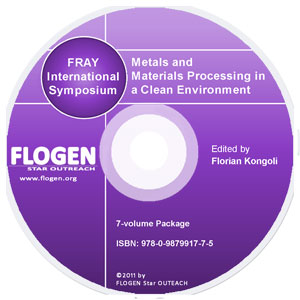
CD shopping page |
2011-Sustainable Industrial Processing Summit
|
| Editors: | Florian K |
| Publisher: | Flogen Star OUTREACH |
| Publication Year: | 2012 |
| Pages: | 764 pages |
| ISBN: | 978-0-9879917-5-1 |
| ISSN: | 2291-1227 (Metals and Materials Processing in a Clean Environment Series) |
Anion-exchange Behavior Of Hf(IV) And Zr(IV) In HCl Solutions
Masahito Uchikoshi1; Kouji Mimura1; Minoru Isshiki1;1TOHOKU UNIVERSITY, Sendai, Japan;
Type of Paper: Regular
Id Paper: 484
Topic: 14
Abstract:
HfO2 is expected to be an alternative gate dielectrics used in ultra large scale integration (ULSI) to the conventional SiO2 thin film. It is required that the materials used in ULSI are sufficiently purified to avoid unexpected errors. Commercial Hf, however, contains > 20,000 mass ppm Zr, which is the most difficult impurity to be removed and causing flat-band voltage shift. Therefore, it is important to establish process of removing Zr from Hf. Furthermore, high purity Hf is indispensable for investigating the intrinsic properties of Hf metal.A lot of processes have been proposed for separation of Hf and Zr. In the industry, solvent extraction and chloride distillation are used. In addition, solid/liquid extraction methods such as chelating or solvent impregnated resins have been reported. Among those we focus on anion-exchange separation which is very useful to purify some transition metals. Anion-exchange behavior of Hf(IV) and Zr(IV) has been reported by a several researchers, but the reported distribution coefficients of Hf(IV) and Zr(IV) vary widely. In this work, we investigate the anion-exchange behavior of Hf(IV) and Zr(IV) by the batch experiment in the condition identical to that in the column separation as possible and determine the optimum condition for separating Zr from Hf.Strongly basic anion-exchange resin, DIAION SA10A supplied by Mitsubishi Chemical Corp., was used. The examined species were dissolved into HCl solutions in the form of chlorides. The mixture of anion-exchange resin and the solution containing the examined species was shaken in the thermostat bath for a certain time. After the resin was filtered, the concentration of the species in the initial and final solution were analyzed by inductively coupled plasma atomic emission spectroscopy, ICP-AES.As a result, adsorption isotherms of Hf(IV) and Zr(IV) from HCl solutions follow the Langmuir isotherm and the distribution coefficient of Zr(IV) is higher than that of Hf(IV) in whole examined range, 8 – 11 M HCl and at 10 – 40 °C. In the range of < 8 M HCl both Hf(IV) and Zr(IV) are not adsorbed on anion-exchange resin. It indicates that negatively charged species does not form in this hydrochloric acid concentration range. And adsorption of both Hf(IV) and Zr(IV) are not as strong as reported. The separation factor assessed from the distribution coefficients determines that the optimum separation condition is in 9.5 M HCl and at 20 °C.